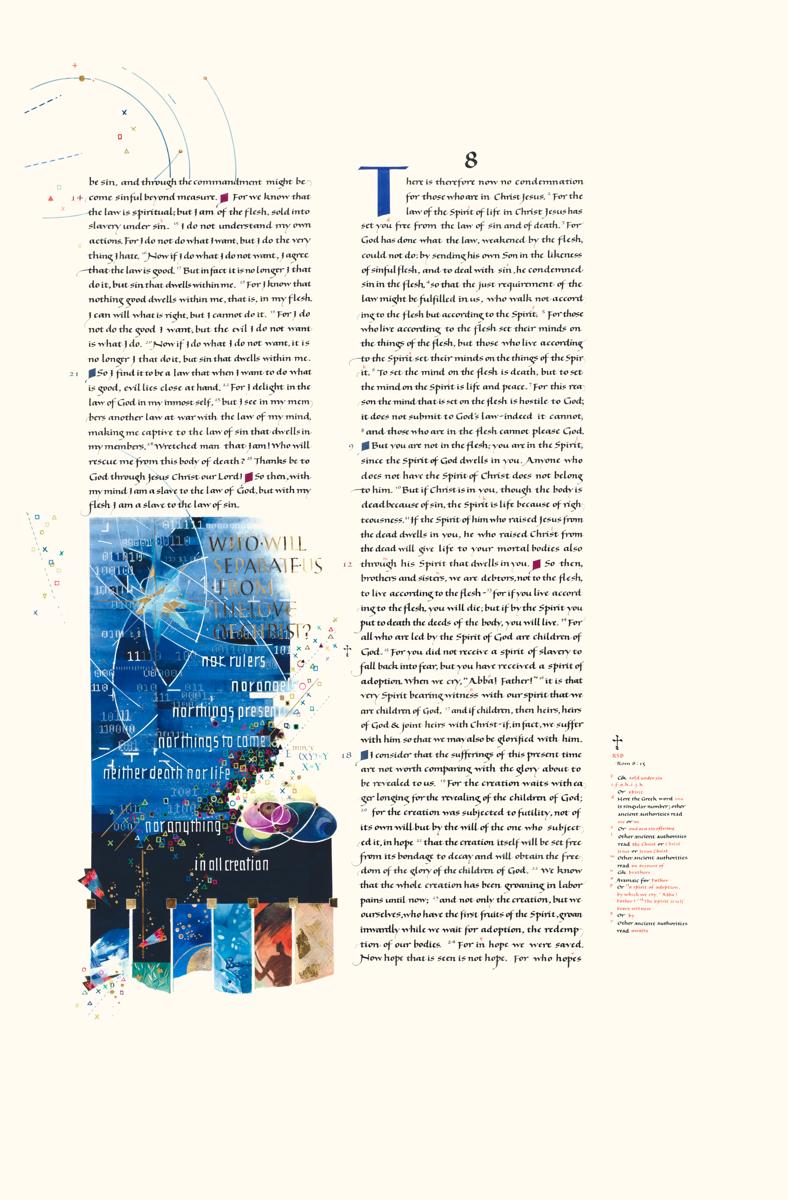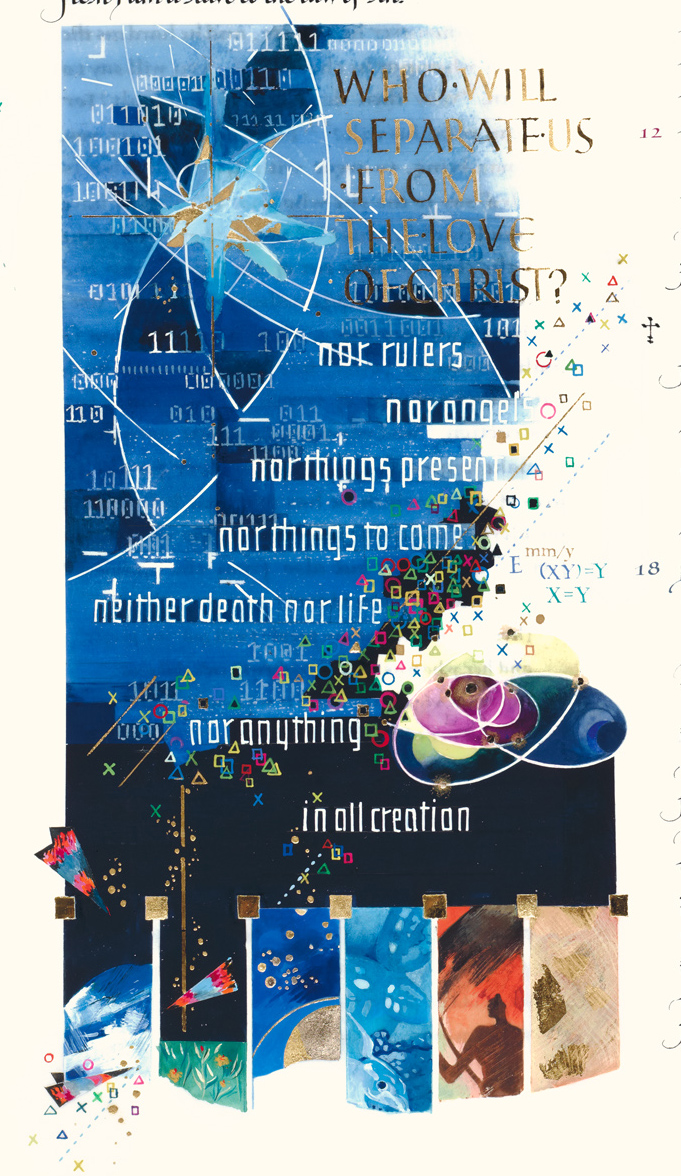December 8: Nothing Can Separate Us from God's Love
♫ Music:
Day 7 - Saturday, December 8
Nothing Can Separate Us from God’s Love
Scripture: Romans 8:37-39
No, in all these things we are more than conquerors through him that loved us. For I am persuaded, that neither death, nor life, nor angels, nor principalities, nor things present, nor things to come, nor powers, nor height, nor depth, nor any other creature, shall be able to separate us from the love of God, which is in Christ Jesus our Lord.
Poetry:
noctilucent
by Matthew Pfaff
father, fill me w/ beauty
& call me beyond
to a training in weight & grandeur
& the glory of small birds.
& father, teach me yr depths & yr heights
& the silences that fill you
and fill me! pull back the tatter of ribs
& take out the stone that sits there,
replace it w/ the gospel
of dawn birds--father, if only
the right words were here this world
would be born anew--what is this thing
you’ve placed in me that shines
w/ precarious substance?
NOTHING CAN SEPARATE US FROM GOD’S LOVE
Relationships oftentimes feel tenuous. No matter how well we know someone there is the chance that something will come between us, perhaps something that is irreparable. Moreover, these days I am not sure if we understand how to form deep relationships when compared to the many superficial relationships that we curate on social media. The Bible says that real friends will lay down their lives for each other (John 15:13). Most of us fail to lay our phones down, much less lay down our lives. The art of human relationships is nearly lost.
It makes sense then that we may experience restlessness in our relationship with God. It is already hard enough to relate to someone who is imperfect like us but how do we relate well to a holy God? Likely, many of us feel that we are not relating to him well. We sin against him, we experience his forgiveness and love and then, alas, we sin against him again and again and again. It seems to be an endless cycle and no human would likely ever put up with such a lopsided and offensive relationship, except perhaps the most patient of parents or spouses.
My wife runs a daycare. Some kids, when they first start coming, experience “separation anxiety.” These little kids are not sure where their parents are or why they left them in a new house with this, at first, strange woman. But in time (rather quickly, actually) they come to see that my wife cares deeply for them and before you know it our house becomes their house – a familiar place full of familiar faces.
Like these kids, we can experience separation anxiety when we feel that God is distant. We reflect on our relationship with him and recognize that it is not as close as we expected. We ask ourselves, have I offended him? Is it God’s nature to leave me here alone with my problems and concerns? It does not take us long to ramp up to a Job-like sense of abandonment. We sense that there is a broken relationship and it causes us great anxiety.
The truth, of course, is that there is no broken relationship. We have not offended God, or at least offended him to the point that he has abandoned us. The apostle Paul assures us that nothing “shall be able to separate us from the love of God.” God has made us his own and there is nothing we can do and nothing that he will do to sever our relationship. We are in eternal relationship with him. Immanuel – God is with us! And we are with him.
Prayer:
Dear God, help me to realize that neither death, nor life, nor angels, nor principalities, nor things present, nor things to come, nor powers, nor height, nor depth, nor any other creature, shall be able to separate me from your love. I ask this through Christ Jesus the Lord.
Greg Peters
Associate Professor
Torrey Honors Institute
Biola University
About the Artwork:
© Fulfillment of Creation
Thomas Ingmire, 2011
The Saint John’s Bible
Saint John’s University, Collegeville, Minnesota, USA.
Used with permission. All rights reserved.
Illuminated manuscript on vellum
15 ¾ in x 23 ½ in
(Two images - one full image of the entire page and the other a detail of the illumination)
www.saintjohnsbible.org
In this contemporary illumination of Romans 8: 37-39 from The Saint John's Bible, the artist Thomas Ingmire, recasts elements of the illumination for the opening of Genesis to emphasize that absolutely nothing that has been created—past, present or future—can separate us from the love of God. References to binary code and other mathematical systems that govern the universe, confirm God as the source and sovereign of all that exists—of the cosmos that He brought out of chaos. Gold is used to symbolize “God’s intervention in the chaos and his ordering of the universe and its elements.” The stages of creation represented at the bottom culminating in the gold strip signifying “the serenity and simplicity of the Sabbath,” that time designated at regular intervals by God in this world to rest and be renewed in God’s presence.
About The Saint John's Bible:
The Saint John's Bible is the first completely handwritten and illuminated Bible commissioned since the invention of the printing press. After a Saint John’s University-sponsored calligraphy presentation in 1995, master calligrapher Donald Jackson proposed a handwritten Bible to Fr. Eric Hollas, OSB, the former executive director of the Hill Museum & Manuscript Library at Saint John's University in Minnesota. Between 1996 and 1997, Jackson created the first sample illuminations while theologians at Saint John’s University developed an illumination schema for the project. The Saint John’s Bible, officially commissioned in 1998, was completed in 2011. During production, Artistic Director Donald Jackson oversaw a group of artists working in a scriptorium located in Monmouth, Wales. Using a mixture of the ancient techniques of calligraphy and illumination, the artists created illuminated manuscripts that were handwritten with quills on calfskin vellum decorated with gold and platinum leaf and hand-ground pigments. Gold leaf was used liberally to represent the divine, silver/platinum to reflect the principle of wisdom, and rainbows to show God’s faithful promises. A wide range of artistic styles, including iconography, abstraction, chrysography, and illustration, were incorporated to create a contemporary visual vocabulary for the sacred. A new script for the sacred text was devised by Donald Jackson to be readable, modern, and appropriately dignified. Meanwhile at Saint John’s Abbey and University in Minnesota, a team of biblical scholars, art historians, and theologians gathered weekly to develop the theological content behind the illuminations. This included not only developing the schema for the illuminations, but also identifying underlying themes and elements for the artists to incorporate. The Saint John’s Bible is divided into seven volumes and is two feet tall by three feet wide when open. It is made of vellum, with 160 illuminations on 1,165 pages. The Saint John’s Bible contains the text and notes of the New Revised Standard Version (NRSV) translation.
About the Artist:
In the world today, Thomas Ingmire (b. 1942) is one of the forerunners of the modern western calligraphy movement. He received a Bachelor’s degree in Landscape Architecture from The Ohio State University and a Master’s degree in Landscape Architecture from the University of California, Berkeley. He worked in the landscape architecture field and in the early 1970s discovered calligraphy. He joined English master calligrapher and illuminator Donald Jackson’s one-year postgraduate program at California State University, Los Angeles. In 1977 he submitted work to the Society of Scribes and Illuminators (SSI) in London, and became the first foreign member to be elected as a Fellow of the SSI. He is one of the illuminators of The Saint John’s Bible. He has taught calligraphy since 1978 and has conducted workshops throughout the United States, Canada, Australia and several countries in Europe as well as in Japan and Hong Kong. His work has focused on the exploration of calligraphy as a fine arts medium and has evolved to a point where it is no longer calligraphy, but abstract calligraphic explorations, which challenge concepts of visual language as an expressive medium. Work has been exhibited widely in the United States, and can be found in the San Francisco Public Library's Special Collections; The Newberry Library in Chicago; The Victoria Albert Museum in London; The Sackner Archive of Concrete and Visual Poetry, as well as many other public and private collections throughout the world
About the Music:
“Nothing Can Ever Come Between Us” from the album Taizé: Venite Exultemus
Lyrics:
Nothing can ever come between us and love of God.
The love of God revealed to us in Christ Jesus.
When I am afraid, Lord, I put my trust in you
In you I trust; I shall not fear.
This I know: that God is on my side
In God I trust; I shall not fear.
About the Composers and Performers:
Taizé is an ecumenical monastic community in Burgundy, France. Founded in 1940 for refugees of the German occupation, Taizé has since become a refuge for people from around the world seeking peace and unity. The brothers welcome pilgrims into their community to share meals and sing together. The songs of Taizé are short, easily memorized phrases from various languages sung over and over in contemplation. This repetition allows the meaning of the songs to sink deep into the soul and to continue in the quiet of the heart long after the music stops.
About the Poet:
Matthew Pfaff is a poet whose work has appeared in publication such as DIAGRAM, Rock & Sling, and Versal. Matt Pfaff completed his doctorate in Comparative Literature at the University of Michigan.
About the Devotional Writer:
Greg Peters
Associate Professor
Torrey Honors Institute, Biola University
Greg Peters is a native Virginian who loves to travel (especially in Europe) and read. When not reading for work, Greg reads for fun. He enjoys the fiction of Paul Auster, Bernard Malamud, Chinua Achebe and the nineteenth century Russian novelists. In addition, Greg loves the poetry of John Donne and George Herbert. When it comes to non-fiction, he enjoys reading anything that has to do with theology, monasticism or the history of the Christian church. When not working or reading Greg enjoys spending time with his wife Christina and their two sons: Brendan and Nathanael. In addition to being a professor at Torrey Honors Institute, Greg is an ordained pastor in the Anglican tradition, serving regularly in his local parish.

